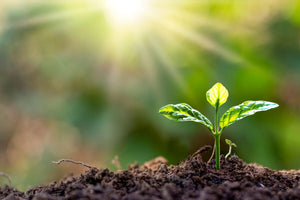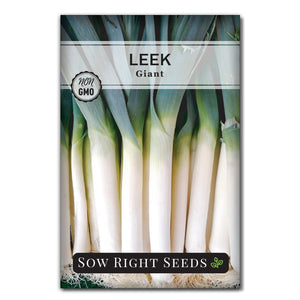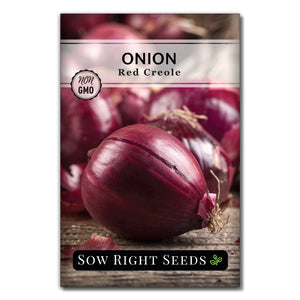Easy Tips on How to Grow Bunching Onions aka Green Onions from Seed
OnionsGrowing green onions, or more specifically, bunching onions, is different than growing leeks or bulbing onions. These onions cross over in many ways, but for a tender, true green onion, you need to adopt a different approach. They deserve their own growing guide. We’re going to focus on Allium fistulosum, which is the Japanese bunching type of onion. However, these growing tips for green onions can be applied to other varieties.

Technically, you could grow any kind of onion to be a green onion if you pull it up when it’s young. However, if you want to grow true green onions that have a straight white and green stalk, then grow bunching onions. These onions, also called Welsh onions, have hollow green leaves on green to white shafts.
Knowing the scientific name can clarify which plant we are talking about, especially when we need to know how to grow it.
All onions are in the Allium family, but the fistulosum genus doesn’t bulb. They can also be more cold-hardy, depending on their variety. These green onions are grown for their tender green shoots and small white shafts. Often in recipes that call for scallions they are referring to the green part of the bunching onion.
Heshiko Bunching Onion is a popular Japanese green onion that grows 12-14" tall. it is a non-bulbing variety that is hardy in cold weather. This mild flavored heirloom onion is delicious in stir-fries, soups, and salads.
Spring Onions vs Green Onions
Sometimes, the term spring onions is used interchangeably with green onions. However, spring onions can refer to bulb onions, which are Allium cepa. When we’re talking about growing green onions, we are referring to Allium fistulosum, which includes Welsh and Japanese onions. These green onions never form a bulb. Spring onions often have a small bulb and, if left to grow longer, can develop a larger bulb.

Growing Green Onions from Seed
Green onions are adaptable to many growing locations. They can be direct sown into the garden, started indoors and transplanted, and grown in containers both indoors and out.
Bunching onions take 60 to 120 days to mature and can be direct sown outdoors as soon as the soil can be worked. They can also be started indoors 6 to 8 weeks before the first frost date. We start our bunching onions indoors from mid-January to the end of January at the same time we start our leeks and onions.
You can succession sow by spacing out your planting every two or 3 weeks. This will allow you to stagger your harvest.
Plant onion seeds ¼ deep in moist soil or seed starting mix.
Seeds can be planted in bunches, whether outdoors or starting inside. When you transplant, you can set out the whole clump together or separate it, as you would leeks and bulb onions.

Bunching Onion Seed Germination Tips
- Use fresh onion seeds. Onion seed viability can deteriorate quickly, and they don’t keep well for more than 2 years.
- Moisture and temperature are crucial for onion seed germination. Keep the soil moist and the temperature between 68-75ºF. Bunching onion seeds can germinate between 50 to 95 degrees, but the optimal is 68 to 75ºF.
- Plant onions in bunches. Some gardeners prefer to plant 8-10 seeds in a group, but 5-6 is usually plenty.
This beautiful bunching onion has a scarlet red coloring at the base of the stems that intensifies with cooler weather. Scarlet Bandit Bunching Onions can be grown in Spring and Fall. It is a non-bulbing heirloom variety that is cold-hardy.
Transplanting Bunching Onions
You can start onion bunches indoors and then transplant seedlings or seed directly outdoors when the soil is warm enough for germination.
When transplanting bunching onions, you can separate the individual seedlings or transplant the whole bunch together.
Space onion bunches 6 inches apart. For individual seedlings, the spacing will depend on the size you want and how you want to harvest them. If you want to harvest a bunch or bundle all at once, then keep them together. They will be on the smaller side and tender. You can also space them out more and have larger onions.
Bury seedlings 1 to 2 inches deep. Green onions are adaptable, and whether you plant them shallow or deep depends on what you prefer. If you like a longer white stalk, you can hill the soil around the plants like you would for growing leeks. This technique is used to grow Negi-style onions, a favorite in Japanese cooking.
Let the soil fill in as you water the transplants.
Keep your onion patch weed-free to keep them from competing for nutrients.

Growing Bunching Onions
Bunching onions are very versatile and will become a valuable crop in your vegetable garden. Bunches of onions can be grown between other plants like kale and Swiss chard.
Sun
Grow bunching or green onions in full sun with at least 6 hours of direct light. They can tolerate some shade, but it will affect how fast and big they grow.
Soil
Water
Water bunching onions often enough to keep the soil moist but not waterlogged. If your soil is sandy you may need to water more often. Heavy clay soil does not need to be watered as often. Drip irrigation works well for growing bunching onions.
Fertilizing
Harvesting
Green onions’ versatility extends into ways to harvest them in your home garden. Large production growers like to have a uniform way to harvest. But green onions can be leaf by leaf as needed or pulled up in bunches at a time.
Green onions are ready to harvest about 60 to 120 days after transplanting. The base is 1/4 to 1/2 inch in diameter, and the white shank is around 2 inches long.
If you only want to eat the green scallion part, you can cut it off and leave the roots to regrow more greens.
When pulling up the whole bunching onion, you may need to loosen the soil with a hand trowel.
Division
If you are growing bunching onions as perennials, you would only harvest the green tops and divide root clumps in the spring.
Green Onion Pests & Diseases
As with any crop, there are pests and diseases to watch out for. Aphid infestations can be treated with natural methods. Onion maggots and thrips are other pests to watch for.
Botrytis and white rot are diseases that can harm onions. Garden sanitation and watering practices can help to avoid these problems.
Growing Green Onions in Pots
Bunching onions are an easy crop to grow in containers. Use fertile potting soil in a pot with good drainage. Regular watering and additional fertilizer will help the onions thrive in a pot. They will still need full sun, and they can be harvested as needed. The containers can be brought indoors during cold spells.

Bunching Onion FAQs
How deep do you transplant bunching onions?
Transplants can be planted 1 to 2 inches deep.
How deep to transplant bunching onion seedlings depends on what you prefer. For longer white stalks that are like leeks, you can plant them deep and leave just a few inches of green above the soil.
How close do you plant green onions?
How close to space green onions depends on your desired end result. Onions planted close together are easier to harvest as a bundle and will generally be smaller. Onions spaced farther apart can grow larger and are easier to harvest one by one.
When do you harvest green onions?
Green onions can be harvested as soon as they are the size you prefer. Usually, they are about the size of a pencil.
Are bunching onions an annual or a perennial?
Depending on how cold your winters get and the variety, you can grow bunching onions as either a perennial or an annual. Some varieties are more cold-tolerant than others. If you pull up the whole plant, it is an annual. If you only harvest the greens, the roots will continue to grow as long as they remain warm enough. Cold frames and polytunnels can extend the season.
Japanese onions, bunching onions, or green onions are wonderfully versatile crops that gardeners love to grow. Try these heirloom varieties and see how delicious and easy they are to grow.








Leave a comment